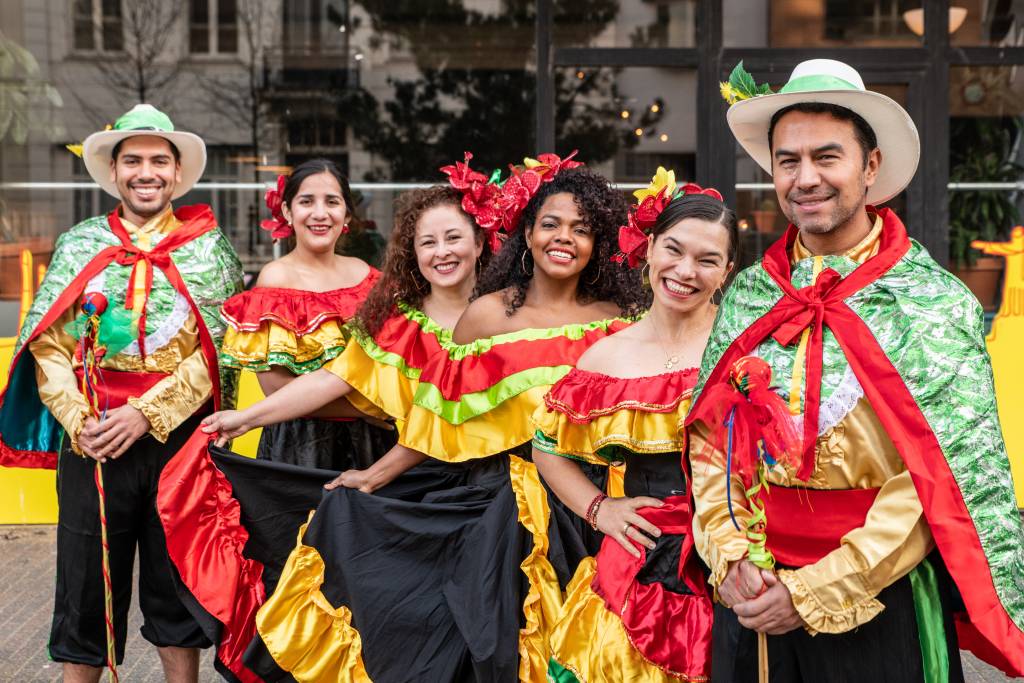Interviews
Grupo Colombia: Representing the diversity of Colombia through dance
"I started dancing Colombian rhythms with other Colombians in Eschede. Then in Eindhoven, linked to the activities of CLO, I started again with other Colombians to consolidate the Colombian group in this city. The dancers of Grupo Colombia represent the diversity of Colombia, a country with a mix of many subcultures. Although I love dancing, my primary role nowadays is to maintain the public relations and design of the costumes. We started dancing at C.L.O. parties and step by step we were gaining recognition and we have performed in several cities in the Netherlands, at events of the Colombian embassy and international parties."
Unesco Heritage
Dorángela Giraldo Arana, also an active C.L.O. volunteer and ambassador for the
International Creative Women: "Music connects hearts and is the language of the soul.
That's my purpose when I dance. I can show the energy, and cultural richness of Colombia, connecting the audience with the best energy, positivism and the good vibe that Colombians have. More than a group we are a family, we take care of each other, we support each other, we love each other. And although it’s purely a hobby for all of us, we’re very dedicated and disciplined. We finance everything ourselves, and to make that possible, we sell food at international parties in order to collect money for paying hats, shoes, textile dresses and decorations. For a carnival party in 2017, we worked one whole week to prepare all ingredients for the complex Colombian food. At the end, we sold everything and with the collected money we bought material for new traditional costumes. My home city in Colombia is Cali, the world salsa capital. Where we don't just dance salsa, because we have a lot of folkloric rhythms that characterize the people of the Pacific region as well as marimba music. I am very proud we dance pacific music in our group as, for example currulao, the best-known marimba music style from the Pacific. There we have the most African-influenced dance styles in Colombia. In 2010, currulao was added to the UNESCO list of Masterpieces of the Oral and Intangible Heritage of Humanity to ensure that this music will live on for many generations to come."
Having lived in Eindhoven for 21 years, Ana Milena Machado, has the longest residency
here: “I am a happy, grateful and active volunteer at the C.L.O. and have been for 20 years. From the start, I have been passionate about being a bridge between Latin America and the Netherlands, together with our fellow volunteers. Our mission at Grupo Colombia is to be the ambassadors of the joy, the cultural richness, the diversity and the flexibility of the Colombians. Sharing that we are a positive,dynamic and participative group. That we came to Eindhoven to join the social and cultural development and to contribute healthily to the diversity in the Netherlands."
Proud of Colombia
A big contrast with Ana is Michael Rodas; as he's only been living in Eindhoven for 9
months, but the group helped him to adapt to the Dutch way of life. "They opened a new
unknown world for me where I have friends and it feels like I belong to something bigger.”
Also for Libardo Navia the group was important for his starting period in Eindhoven: "Grupo Colombia changed my life in Eindhoven. It allowed me to meet many great and funny people. Every week we train our choreography it is very cool; we laugh a lot and we eat together. Also, as I am not good at dancing, I find it challenging to prepare the performances with the members of the group." In september 2019 Stephanie Villegas Martinez joined the group. "Although I"m a new member, I"ve enjoyed myself very much. I moved to the Netherlands over 8 years ago, creating choreographies and to perform Colombian traditional dances is a very nice way for me to stay in touch with my roots. Originally I"m from Barranquilla, the city called the “golden gate of Colombia “. The carnival is the second largest in the world, second only to Rio de Janeiro. In 2003, it was also added to the UNESCO Heritage list."
For Melissa Vargas it's also important to stay connected to Colombia: "Although I'm abroad, I can do positive things for Colombia like showing the beauty of its culture, its happiness and its diversity. Furthermore, I really enjoy dancing and hanging out with all the group members. I've also learned to overcome the fear of performing in public." Being in the Netherlands for 19 years, Kike Sanjuanelo works at Philips as an architect. "I love the music from my homeland, therefore I joined Grupo Colombia, but beside that I have a vallenato music group called “San Pués” which is a tribute to a small town in Colombia. The vallenato is a musical genre of the north-east of Colombia, and like currulao music and Barranquilla carnival it, is also on the UNESCO Heritage list." Silvia Ardila loves the diversity of the music and dance: "Our dances represent every corner of our country. The dances and our rhythm are a consequence of the mixture of races and cultures: black, white and Indian people." Juan Francisco Sanchez agrees and adds: "Dancing has its challenges: once I ripped my pants during a performance, another time I fell backwards but managed to make it look like it was part of the dance. Perhaps the most fun we have is during the rehearsals: we eat together, share a laugh, and of course, dance."
Needless to say that Grupo Columbia is an esteemed guest at many events: with their colorful costumes, thumping music rhythm and exuberant dances, they take you to warm and sunny Latin America. More information about Grupo Colombia and for bookings, please contact Sally Ocaña, tel. 06-23 61 97 03 / s_ocana@hotmail.com.

